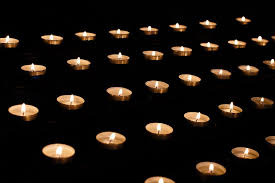Or at least the stories associated with death because there are a lot.
Confused about why I chose this topic as my kick off to 2018? That's alright, I'm often confused by where my mind goes when it's left to wander around without a focal point to focus on. But I've been traveling around the Internet (and received a request to look into the myth of Sisyphus - basically the story of a guy trying to get out of dying) and stumbled upon a ton of mythology and folklore about that unknowable experience that is death and the afterlife.
I'm not really surprised by the number of stories associated with death, the afterlife, and dealing with the dead. It's one of the greatest mysteries about life. What happens after we die?
There are a lot of theories. The atheists I've talked to all say that there's nothing after death. Basically we just go poof. Reincarnation is another popular possibility and one I favor (one life time is just too short to experience everything this world has to offer). However, places such as underworlds seem to pop up a lot in the different mythologies and religions I'm most familiar with.
Growing up as a Protestant Christian, I was taught that good people go to Heaven and bad people go to Hell. My Catholic relatives might have talked about Purgatory on occasion (and were a little confused as to what happened to the Souls there when the Papacy no longer recognized it), but it wasn't really part of my belief system.
Of course, Christianity isn't the only religion in the world and doesn't have a monopoly on afterlife doctrine and it has gone through a number of changes over the years. There are a number of influences from Greek and Roman mythology (*cough Hades *cough), not to mention Norse mythology (*cough Hel *cough).
In fact, one of the most famous depictions of Christian afterlife, Dante's Divine Comedy, could easily be described as gratuitous self-insert fanfiction. Sadly, these aren't my words, I stole them from Overly Sarcastic Productions (I might reference this YouTube channel a lot in this post).
I could go on about the many depictions of Heaven and Hell (like I've written in all my posts about Folklore and Mythology), but that would create a sub-series into this series and I would prefer to avoid doing that. I also don't want to just list off the many different afterlife places that ancient people said they were going to. That would take forever and require more research than I'm willing to put into this post.
With that written, I want all of you reading to take a quick detour to YouTube to watch this video on underworld mythology and this one about a guy kidnapping death by Overly Sarcastic Productions (see, I told you guys they'd be referenced again) you can get a quick overview of a few myths I've been looking into. I'll wait for you to come back...
My general feelings on underworld and death mythology is that it's trippy as all get out. They have two basic flavors such as when one member of a loving breeding couple dies tragically or someone doesn't want to die, captures death, and causes tons of problems because of the situation (insert facepalm here).
Then there's the mythology and folklore about Death itself (not the act of dying, the physical embodiment of death). Usually, I think of Death as the skeleton like figure cloaked all in black, carrying a scythe known as the Grim Reaper. It's the image that has been ingrained in America's popular culture. Lindsay Ellis did a really interesting YouTube video on the depiction of Death in popular culture (mainly movies) and how this image has barely changed over the years.
The idea of Death as a person has actively been a part of my culture since I was a kid. I remember watching the shows "The Grim Adventures of Billy and Mandy" and "Dead Like Me". J. K. Rowling and Sir Terry Pratchett created their own versions of Death for their respective fantasy worlds. The common denominator between all of these versions is that Death just kind of wants to do their job and doesn't like it when the natural order is messed with.
 |
| The dementors from Harry Potter look a lot like the modern interpretation of the Grim Reaper |
Also if you do try to rescue your dead loved one from death/the underworld, don't turn around until you've gotten back to the land of the living.
I'm off go back to working on my coming-of-age-horror novel (which is partially why I did this research in the first place - no spoilers). Hopefully I'll be able to finish it before it's 2019. Until next week.
If you enjoyed this post (or it really pissed you off) please like, share, and/or leave a comment. I love hearing from my readers and I hope you guys like hearing from me.





